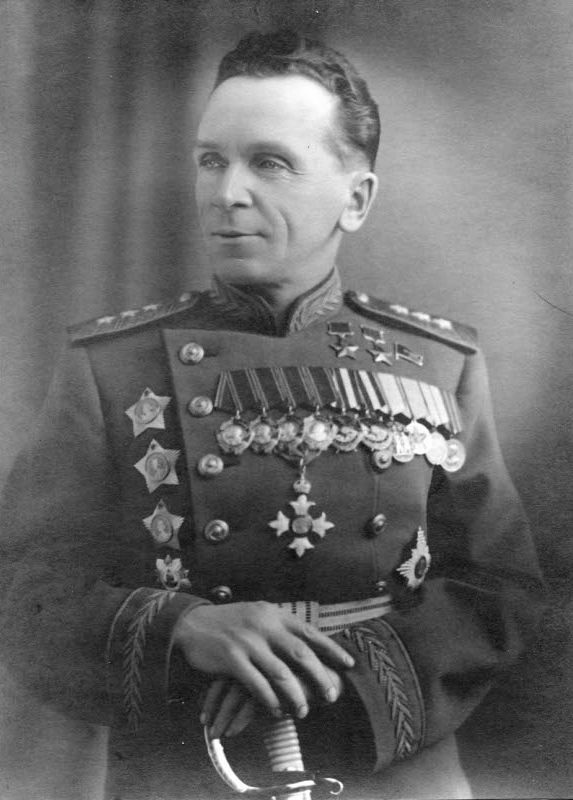
Soviet Army general who served with the Bryansk Front and in the Battle of Kursk, among many other engagements. Born on June 1, 1897, in the village of Filisovo in the Rybinsk region of Yaroslavl Province, Russia, Pavel Batov entered the army in 1915 during World War I and fought on the Russo-German front. He won two St. George crosses and was wounded in combat in 1917. On his recovery, he was assigned to the noncommissioned officer (NCO) school in Petrograd, where he became a convert to Bolshevism.
Batov joined the Red Army in August 1918 and fought in the Russian Civil War. Between 1926 and 1927, he attended the Vystrel Officers’ School. On graduation, he took command of a battalion of the 1st Moscow Proletarian Rifle Division. He served with this division for nearly nine years, commanding its 3rd Rifle Regiment in 1933. In 1936 and 1937, he served as an adviser to the Republican side in the 1936–1939 Spanish Civil War and was twice wounded.
Promoted to brigade commander on his return to the Soviet Union in December 1937, Batov took command of the X Rifle Corps. In early 1938, he assumed command of the III Rifle Corps. At the same time, he served on a special commission to recommend the restructuring of Red Army mechanized and motorized forces. The commission’s report, approved in November 1939, unwisely recommended abolishing the army’s 4 tank corps and replacing them with 15 smaller motorized divisions.
Batov’s III Corps of four divisions participated in the September 1939 Soviet invasion of Poland and in the February–March 1940 phase of the Soviet invasion of Finland. His service in Finland earned him promotion to lieutenant general in June 1940, and soon thereafter, he was named deputy commander of the Transcaucas Military District. In June 1941, Batov was summoned to Moscow and given command of the IX Separate Rifle Corps in the Crimea. No sooner had he taken up his post then the Germans invaded the Soviet Union.
In October 1941, Batov became deputy commander of the Fifty-First Special Army. From January to February 1942, he commanded the Third Army of the Bryansk Front, and from February to October 1942, he was deputy front commander. He then headed the Fourth Tank Army, the redesignated Sixty-Fifth Army, in the Stalingrad area.
Pavel Ivanovich Batov, commanded the Soviet 65th Army through 1942-3, was assigned to this post as the battle for Stalingrad reached its peak. The evolution of 65th Army shows many of the reasons for the improvements in the Red Army as a whole. Originally raised as 28th Reserve Army in early 1942, it was prematurely committed to the disastrous attempt by Semyon Timoshenko to recapture Kharkov that spring. The German counter-attack that destroyed much of Timoshenko’s forces threw 28th Army back to the Don, where its staff was ordered to hand over their units to neighbouring armies and to start the formation of 4th Tank Army in the Volga valley. When Batov arrived to take command of this army, he was astonished to discover its current tank strength amounted to only four tanks; when he raised this with his superiors, the army was renamed 65th Army.
Unlike the opening months of the war, nearly all of the senior staff officers of Batov’s new army were veterans with experience of staff posts and hard combat behind them. The only exception was the commander of the communications section, Captain Borissov, but his skill in maintaining communications between army headquarters and its constituent divisions earned him high praise, and the constant fighting on the flanks of the great German bulge around Stalingrad ensured that even he too soon became a veteran. When the army was thrown into the great counter-attack that encircled the German 6th Army in Stalingrad, the staff officers were experts at cooperation and coordination.
Following the Soviet victory at Stalingrad in January 1943, Batov fought in the Battle of Kursk (July 5–13, 1943), the crossing of the Dnieper River, and the drive through Belorussia into East Pomerania and across the Oder River. Batov was popular with his men because he was one of the few senior officers who visited the front lines and conversed with the soldiers.
Promoted to colonel general in June 1944, Batov was in the Northern Group of Forces between 1944 and 1948 and was first deputy commanding general of Soviet forces in the occupation of East Germany. Promoted to army general in 1955, he commanded the Carpathian Military District from 1955 and 1958 and participated in suppressing the 1956 Hungarian Revolution. Batov commanded the Baltic Military District between 1958 and 1959 and the Southern Group of Forces in 1961 and 1962. He served as chief of staff of Warsaw Pact forces between 1962 and 1965. He then served as inspector general in the Soviet Ministry of Defense until his death in Moscow on April 19, 1985.
References
Bialer, Seweryn, ed. Stalin and His Generals: Soviet Military Memoirs of World War II. New York: Pegasus, 1969.
Glantz, David. “Pavel Ivanovich Batov.” In Stalin’s Generals, edited by Harold Shukman, 35–43. New York: Grove, 1993.